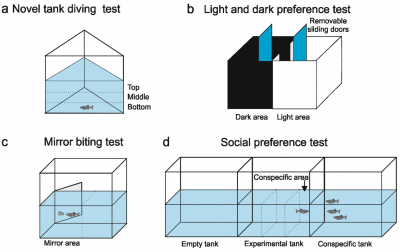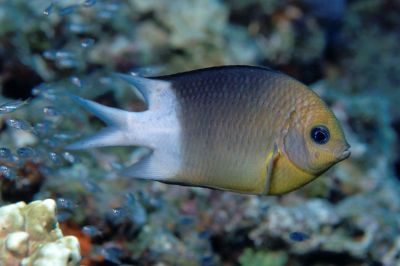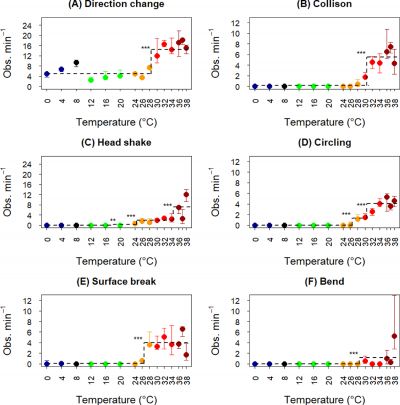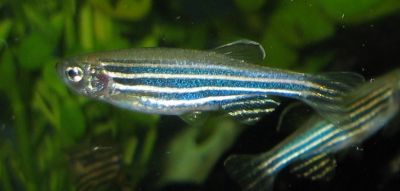The Impact of Warmer Water on Fish Behavior
We know that rising temperatures are already harming the ability of corals to survive and sustain themselves, but less is known about how fish are affected. If our oceans continue to warm, we need to know how fish are going to respond to that change in order to protect them effectively. This article presents existing research on how warmer waters impact fish behavior. There are 5 studies discussed here, with a variety of species and environments covered by existing research. Across all sources, higher water temperatures and subsequent heat stress leads to various detrimental effects, such as risky behaviors, physical pain, poor thermoregulation, increased metabolic demands, and in the most extreme cases, death.


Schematic representation of the experimental design[1]
In a 2020 study supported by Sapienza University of Rome, researchers investigated the effects of increased temperature on adult zebrafish behavior [1]. Zebrafish were chosen due to their wide thermal tolerance range and common use in experiments. Two tanks were used: a control at 26 degrees C and a tank that gradually increased temperature up to 34 degrees C. These conditions were maintained for 21 days, then 12 fish were randomly selected to undergo a battery of 4 tests. The novel tank diving test, light and dark preference test, mirror biting test, and social preference test measured the exploratory tendencies, light preference, aggression, and sociability, respectively.
The results found greater vertical exploration and boldness in the treated Zebrafish, as well as greater preference to light areas and less time spent in social areas [1]. This behavior is comparable with actions in the wild that can endanger the survival of the fish, such as swimming further away from their school or entering areas with a greater risk of predation, as they are more likely to act boldly and submit themselves to danger. The scientists believe that these behavioral changes could lead to lower survival rates in the wild. If these effects apply to many fish species, the ramifications could be devastating to global fish populations as temperatures continue to rise.


spiny chromis damselfish (Acanthochromis polyacanthus)[2]
Warmer temperatures not only affect the potential survival rate of fish in the wild but also negatively impact their neurological function and ability to learn. A recent 2023 study on spiny chromis damselfish (Acanthochromis polyacanthus, pictured left) aimed to determine how warmer temperatures affected their memory and learning capacity. The study had three groups of fish, a control group held at 28-28.5 ℃, as well as moderate and high warming groups held at 30-30.5 ℃ and 31.5-32 ℃ respectively. Each group of fish spent two weeks in this temperature of water, and were then trained to associate a cue to a reward. After 5 days of training, the fish were tested for learning and then for memory storage over 5 day intervals [3]. The study showed that fish in the control group showed the best learning and memory retention. Specifically, fish in warmer water learned more slowly and showed reduced cognitive function [3]. This is yet another sign that warming temperatures may lead to increased deaths within fish populations.
Another study published in the Cornerstone Journal analyzed the feeding behavior and habitat use of two freshwater fish species, black crappie (Pomoxis nigromaculatus) and black bullhead (Ameiurus melas), in warmer water [4]. The study observed that an increase of 2°C over four weeks resulted in a 35% decrease in feeding events for black bullheads and a 22.2% increase for black crappies. Significant changes in habitat use were also noted: black bullheads increased their use of open areas and plant cover, while black crappies increased their use of open areas and swimming behavior. These changes could lead to environmental instability and increased competition, as warmer temperatures disrupt metabolism, respiratory function, and energy budgets, leading to stress [4].
In a detailed study published in ScienceDirect, researchers examined the behavior of Atlantic Salmon acclimated to 8°C water [6]. The purpose of this study was to address concerns that the fish feel pain when undergoing the delousing process, which consists of exposure to water at temperatures around 28-34 degrees C. The need for thermal treatment is dictated by the resistance of the salmon louse (Lepeophtheirus salmonis) to traditional chemotherapeutants [6]. It is important to note that the lethal temperature for Atlantic Salmon has been found to be 30-33 degrees C, where the fish cannot survive for more than 10 minutes [7]. The salmon were exposed to a range of temperatures from 0°C to 38°C to assess their response. The researchers found that temperatures above 28°C caused significant distress, as evidenced by thrashing behaviors indicative of pain. When the fish can no longer maintain its equilibrium (called reaching endpoint in the study), it will lay on its side in the water, which is a direct sign of extensive tissue damage and that the fish is nearly dead. In the experiment, when fish reached their endpoint they were netted out and euthanized to prevent any further pain. During the treatment time under high temperatures up to 38 degrees C, researchers witnessed behavioral events like thrashing, uncontrollable collisions with the tank, sideways bending of the fish, and surface breaks where the fish came out of the water. These events are indicators of extreme thermal stress and potential pain, even though exposure time to all treatment temperatures was limited to 5 minutes [6]. This temperature threshold for reaching endpoint is specific to Atlantic Salmon and highlights the severe impact that excessive heat can have on their wellbeing, suggesting that similar effects may occur in other fish species under comparable conditions . Thermal stress is different between fish species, however this study shows that certain fishes are more vulnerable to warming waters than others. While it is important to remember that the most extreme temperatures experienced by the salmon in this experiment are unrealistic for their habitat and anything they will experience in the foreseeable future, this still shows how potential elevated temperatures can increase the amount of stress faced by many types of fish.


Median observed frequency of behavioural events per minute before end of
exposure (300 s) or laying on the side for the fish in each temperature
group[6]
A PLOS ONE study revealed that brook charr (Salvelinus fontinalis) employ various thermoregulatory tactics to cope with warmer water. The fish were observed in Lake Ledoux, where temperatures were higher than usual. Brook charr utilized four main thermoregulatory behaviors, including reducing their selected temperatures and limiting daily movements when the epilimnion temperature exceeded 22.4°C. They moved to deeper, cooler water and exhibited decreased horizontal and vertical movements [8]. While these behaviors help manage heat stress, they restrict habitat usage and increase overall stress, potentially affecting long term survival and growth rates.
Common Trends and Differences
The studies on the effects of warmer waters on fish behavior reveal several common trends and important differences. Generally, higher temperatures result in significant cognitive impairment, altered behavior, and increased stress for various fish species.
Cognitive Impairment
Studies consistently show that elevated temperatures impair learning and memory in fish. For example, the damselfish study indicated that fish in warmer waters learn more slowly and show reduced cognitive function, suggesting that neurotransmitter activity is hampered by higher temperatures.
Behavioral Changes
Increased temperatures often lead to bolder and riskier behaviors. The zebrafish study found that fish subjected to higher temperatures exhibited increased boldness and were more likely to engage in dangerous activities such as swimming further from their school. Similarly, the study on brook charr observed changes in behavior due to thermoregulatory tactics.
Thermoregulatory Tactics
Fish employ various strategies to cope with heat, such as moving to cooler areas or altering their daily movements. The brook charr study noted that fish moved to deeper, cooler waters to manage heat stress, although this increased their overall stress and potentially affected longterm survival.
Physical Stress
Warmer water results in increased metabolic demands, disrupted respiratory functions, and physical distress [6]. For example, the Atlantic Salmon study showed that temperatures above 28°C caused thrashing behaviors, indicating significant pain and distress.
While these common trends highlight the detrimental effects of rising temperatures on fish, differences in species' responses underscore the variability in temperature thresholds and specific impacts. For instance, black crappies and black bullheads exhibited different feeding behaviors and habitat use when exposed to warmer waters.
Future Possibilities
As global temperatures continue to rise, the impacts on fish behavior and physiology will likely become more pronounced. The studies reviewed indicate a trend of increased stress, impaired cognitive function, and altered behaviors, all of which threaten the survival and stability of fish populations. Addressing these issues is urgent to protect fish and maintain the balance of marine ecosystems.
Understanding these impacts can inform conservation strategies and highlight the importance of mitigating climate change to preserve aquatic life and biodiversity. For example, protecting cooler refuges within habitats or managing fish populations to reduce stress could help mitigate some of the negative effects of warming waters. Additionally, further research into the specific needs and responses of different fish species will be crucial for developing effective conservation and management plans.
The evidence strongly suggests that rising water temperatures have profound and often detrimental effects on fish behavior and physiology. Immediate and concerted efforts are needed to address this issue to ensure the survival and health of fish populations worldwide.
References
- [↑ 1.0 1.1 1.2 Angiulli, E., Pagliara, V., Cioni, C., Frabetti, F., Pizzetti, F., Alleva, E., & Toni, M. (2020). Increase in environmental temperature affects exploratory behaviour, anxiety and social preference in danio rerio. Scientific Reports, 10(1). https://doi.org/10.1038/s41598-020-62331-1]{#cite_note-angiulli-1}
- [↑ https://fishesofaustralia.net.au/home/species/311]{#cite_note-australia-2}
- [↑ 3.0 3.1 Silveira, M. M., Donelson, J. M., McCormick, M. I., Araujo-Silva, H., & Luchiari, A. C. (2023). Impact of ocean warming on a coral reef fish learning and memory. PeerJ, 11. https://doi.org/10.7717/peerj.15729]{#cite_note-silviera-3}
- [↑ 4.0 4.1 Walberg, E. (2014). Effect of increased water temperature on warm water fish feeding behavior and habitat use. Journal of Undergraduate Research at Minnesota State University, Mankato, 11(1). https://doi.org/10.56816/2378-6949.1035]{#cite_note-wahlberg-4}
- [↑ https://sharkresearch.earth.miami.edu/investigating-atlantic-salmon-dive-behavior-in-the-norwegian-and-barents-seas/]{#cite_note-miami-5}
- [↑ 6.0 6.1 6.2 6.3 6.4 Nilsson, J., Moltumyr, L., Madaro, A., Kristiansen, T. S., Gasnes, S. K., Mejdell, C. M., Gismervik, K., & Stien, L. H. (2019). Sudden exposure to warm water causes instant behavioural responses indicative of nociception or pain in Atlantic Salmon. Veterinary and Animal Science, 8, 100076. https://doi.org/10.1016/j.vas.2019.100076]{#cite_note-nilsson-6}
- [↑ Elliott, J. M., & Elliott, J. A. (2010). Temperature requirements of Atlantic Salmonsalmo salar, brown troutsalmo truttaand arctic charrsalvelinus alpinus: Predicting the effects of climate change. Journal of Fish Biology, 77(8), 1793–1817. https://doi.org/10.1111/j.1095-8649.2010.02762.x]{#cite_note-elliott-7}
- [↑ Bertolo, A., Pépino, M., Adams, J., & Magnan, P. (2011). Behavioural thermoregulatory tactics in Lacustrine Brook Charr, Salvelinus fontinalis. PLoS ONE, 6(4). https://doi.org/10.1371/journal.pone.0018603]{#cite_note-bertolo-8}

